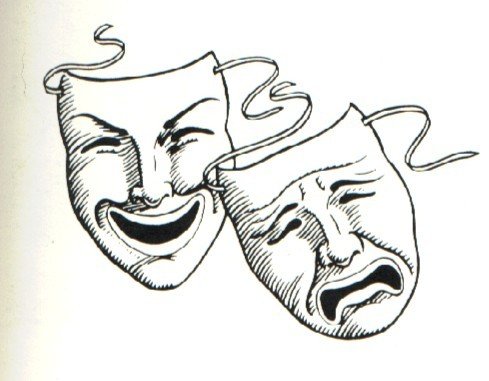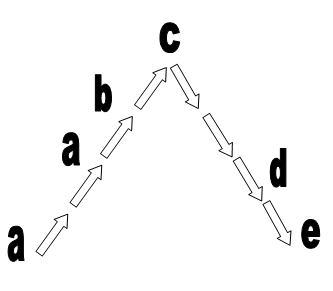Drama:
In its most general sense the term is used to refer any work designed to be represented on a stage by actors; more strictly, it is a serious play dealing with problem of importance, but not aiming at tragic exaltation. The use of the term owes its origin to mid 18th Century France, when Diderot and later Beaumarchais used the word, Drama, to describe their plays of middle-class life. In Modern usage, however, the word Drama is frequently extended to all serious plays. Drama is thus a literary form designed for the theater, in which the representation is by actors who impersonate the characters and perform the action and dialogue.

Tragedy:
Greek: tragoidia , goat song. Probably it refers to an ancient totemic ritual, the sacrifice of a goat associated with Dionysus, the god of the fields and vine yards. With the passage of tie contests in the writing of tragedies came to be held as a part of the ceremonies of the Greek Dionysus of Athens, the spring time festival of the death and resurrection of God. The Greek tragedy develops out of these contests.
Tragedy, in brief , is a dramatic poem or composition which represents impotent events or series of events in the life of some person or persons , in which the style is grave or dignified, the movement is impressive and stately and the end unhappy.

Greek Tragedy, Structure:
A Greek Tragedy consisted of following: -
- Prologue:
The introductory Scene, in the form of Monologue or Dialogue, which is devoted to exposition, though portrayal of character is often important, before the entrance of chorus.
- Parados:
The Song accompanying the Chorus, which sets forth further the exposition or foreshadows the tragedy of the play. - Episodes:
They were frequently four or five which obtained the action of the play , and were separated by choral Odes , or stasimons, in which one or more actors took part , with the Chorus. In some plays, part of an episode was a Commos, which was a lamentation involving actors and chorus. - Stasima:
Songs of the Chorus, now, standing in one place, and expressing emotions rising from Drama. - Exodus:
The Last or final section following the last ode sung and danced by the Chorus.
Freytag’s Pyramid:
Gustav Freytag described the structure of the well-made play, emphasizing rising action, climax and falling action. The pyramid or diagrammatic plot is indicated below:-
a) Introduction/Exposition
a) Enticing moment
b) Rising action
c) Climax
d) Falling Action
e) Catastrophe/denouement
Chorus:
Greek Chorus, a company of dancers or singers. The Greek drama originated from the Chorus, where a dance was performed by a number of persons a ring, in honour of Bacchus the Greek god of wine and love, accompanied by the singing of sacred odes. In continuation of the early tradition, a company of persons, represented as of age, sex, and estate appropriate to the play, who took part as their leader, with the actors in the dialogue of a drama and sang their sentiments at stated intervals when no actor was on the stage. The importance of the chorus declined, as drama progressed. In Aeschylus, the Chorus takes part in the action of the play; Sophocles uses it as a commentator on the action; Euripides gives it a lyrical quality, Elizabethan dramatists in the use of the Chorus had the Roman dramatists as their models. In Henry v, Shakespeare employs the Chorus as a commentator on the action, imparting it the character of an individual. In modern plays Chorus is little used, though T.S Eliot presented multiple Choruses in Murder in the Cathedral and Arthur Miller the single Chorus in A View from the Bridge.
Exposition:
There are four chief types of composition viz., exposition, argumentation, description and narration. Exposition aims at giving the necessary information about the characters and situation at the beginning of the play and novel. Its purpose is to explain the nature or an object, idea or a theme. In a drama exposition is the introductory material, which provides the tone, gives the setting, intr oduces the characters and supplies other facts relevant to an understanding of a play. Shakespeare does this with directness in Richard III and Henry v; in Hamlet and Othello he combines information with action. The exposition presents a particularly difficult problem in a modern realistic drama, for the playwright in it has to provide a great deal of information, which has somehow to be conveyed with ease and naturalness. Ibsen is a master of exposition in modern times; he developed the technique by gradually revealing the past as the play developed. The exposition contains one of the tests of a playwright’s technical skill.
oduces the characters and supplies other facts relevant to an understanding of a play. Shakespeare does this with directness in Richard III and Henry v; in Hamlet and Othello he combines information with action. The exposition presents a particularly difficult problem in a modern realistic drama, for the playwright in it has to provide a great deal of information, which has somehow to be conveyed with ease and naturalness. Ibsen is a master of exposition in modern times; he developed the technique by gradually revealing the past as the play developed. The exposition contains one of the tests of a playwright’s technical skill.